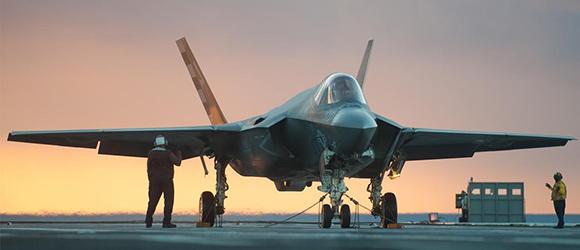Not that it wasn't serious yet, but now our government is in need of a shot to figure out what is actually happening to the JSF program. And we are not asking for a political response ("without 90 F-35 we would no longer have a" most popular "aviation), but a technical one.
Premise, a must. We have been following the F-35 for years and in some ways our correspondence with Lockheed's offices is almost daily. From American society they have always responded with grace and in great detail. Now, however, it's time to clarify what the F-35 is. Beyond the consents obtained and the contracts signed and then reduced, the feeling is that few, outside the American borders, are really supporting the program.
Beyond the fierce criticism the certain fact is that the Lightning-II, in the end, will be in service with a dozen large Allied air forces. Needless to deny it. Cost increases, inevitable political repercussions and negative projections on orders placed by the military: these are the main enemies of the JSF. And while orders appear to be made with the dropper, the unit price for each individual fighter continues to increase as well as the costs of research, development and production start-up. The leavened costs, apparently out of proportion, then trigger the policy resulting in the cancellation of previously signed orders. Further increase in the final price and consequent reduction of the fleet with inevitable embarrassment among international partners.
All branches of the US military, beyond the orders of the partners, will acquire an impressive number of JSFs. It would be correct to say that the fighters sold abroad, to date, are irrelevant to the survival of the fighter. The result is a plane that many would like to erase, but that will sail the skies. And it is also fair to note, for the umpteenth time, what the F-35 really is: a tactical platform designed to excel in contexts that emphasize the Beyond Visual Range (BVR), in environments with a high intensity of information connected to the network. If they work as promised, the aircraft's capabilities will be truly remarkable.

A fighter (don't even think about the aerial dominion or supremacy, that will be up to the F-22 and EFA2000) designed for the war of the future, but it will probably be used in roles that its designers don't even imagine. The Joint Strike Fighter will have to replace the F-16, F-18 Hornet, Tornados, Amx, Harrier, F-5 and A-10.
In these years we have always had doubts about the role of F-35 in Close Air Support for a purely conceptual question. The tactical support is carried out by aircraft with strong abilities to suppress enemy antiaircraft defenses and able to face opposing terrestrial forces in the proximity of those friends. These missions must necessarily be carried out by sturdy, extremely agile low-level aircraft, capable of pouring enormous firepower, collecting the enemy's blows and returning to the base even if heavily damaged. A task carried out even today, from the first flight in the 1976, from the A-10 (photo): a monstrous machine. We have written dozens of insights on the matter, but from Lockheed they have always reiterated the basic concept of JSF: designed for the future. Therefore, the F-35 will have to rewrite the new way of operating in Close Air Support with the same effectiveness as A-10. We have repeatedly expressed our doubts in this regard in terms of armor, firepower and survival and we invite you again to consult our in-depth information on this. Comparative tests with the A-10 will begin in the 2018, but state-of-the-art technology can do nothing against small arms that can put an F-35 out of action and leave the troops to the massacre.
Then there is that last figure, in terms of costs, which should at least make the United States reflect (not Italy): an A-10 has a cost of 11,500 dollars per flight hour. The F-35 costs a little less than 33 thousand dollars per flight hour. Yet the estimates were totally different. The 35 F-1994 should have cost 28 million dollars for the Air Force, 35 million dollars for the Marine Corps and 38 million dollars for the Navy. With today's change, those estimates would have been 45 million for the aircraft that would have equipped the Air Force up to the Navy version that would have cost 61 million dollars. "In the 2015, by contrast, according to the Congressional Research Service's calculation, the unit cost of an F-35 is approaching that of an F-22".
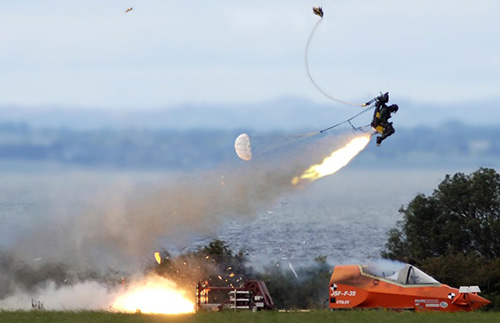 In addition to the known problems confirmed by Lockheed, more are being added. The last technical problem, in chronological order, is very serious and would not seem to be able to be solved with the next software. This is a "potentially fatal mistake for the life of the pilot". This error already has a number of potential victims: one third of the pilots who will fly with the F-35.
In addition to the known problems confirmed by Lockheed, more are being added. The last technical problem, in chronological order, is very serious and would not seem to be able to be solved with the next software. This is a "potentially fatal mistake for the life of the pilot". This error already has a number of potential victims: one third of the pilots who will fly with the F-35.
In the ejection phase, so we are in emergency conditions, the system would cause such a violent whiplash due to an incorrect position of the seat propelled outside the aircraft. The risk, recognized by the Department of Defense (so it is not a hypothesis without foundation), is real for pilots between 60 and 65 chili. The Pentagon itself does not know how to solve this problem. Tests have shown that pilots, whose weight is approaching just short of or in excess of the 135 / 140 pounds, have a probability of death equal to 98% during expulsions to 160 knots. For those who do not know it, the average speed of a take-off or landing. American pilots enabled with the F-35 who fall into this weight category are equal to 7%. Their authorization has been suspended. But the problem may have been underestimated because the risk percentage remains high even for drivers with an average weight.
The main problems: data sharing
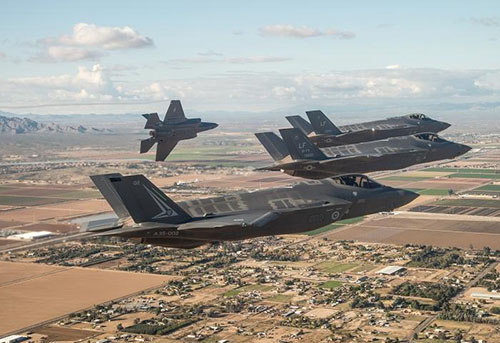
Today we know that it would not be prudent to launch F-35 against Russian or Chinese fighters. The current F-35 technology, at the right price, could have changed the fortunes of a battle, but only then years ago. Today our rivals hold technologies that nullify the hypothetical advantages of the F-35. If the F-35 collided with a Su-30 (advanced fourth-generation fighter) it wouldn't have a chance.
The F-35B presents problems on sharing data collected by fighters in the configuration of four aircraft. The strategy adopted by the Marines is to fly 2 + 2 fighter formations. The merger of data on threats detected by a team of four fighters is not well managed by the current software. Consequently, the F-35 has some difficulties in identifying the real number of enemy targets on the radar. Better, therefore, to make them fly in pairs. The problems have been identified in the collective 'fusion' of the detected threats, one of the strengths of the future 'Game Changer'. The data transmitted to the pilots, at times, are not the real ones. Lockheed Martin should solve the problem with the 3F software block. Therefore, the Marines will make the F-35 fly in pairs instead of four. This configuration showed greater reliability and low levels of false alarms, absolutely manageable.
The cell
During a test carried out on the B model, it was discovered that the 496 bulkhead, bearing section of the fuselage, after four thousand flight hours tends to break. Due to the structural changes made in the 2005, the officials decided that the F-35B was too heavy to be operational and removed some key parts from the original design. They succeeded by using aluminum instead of titanium in some sections of the structure. It should be noted that the cyclical structural problem occurs in the middle of the cell's operational life (each F-35 should fly for eight thousand flight hours) and that, at least until then, the problem will not affect the aircraft's capabilities. From the Pentagon they have reiterated that to date it is not a priority, but it is a problem that will have to be addressed if the fleet is grounded. The cells of models A and C showed high reliability even after ten thousand hours of testing. The JPO plans to test each model for 24 thousand hours, the equivalent of three lives of a cell.
The engine
Among the updates deemed "necessary" there is a new engine that can reduce fuel consumption and increase performance. Each new engine will cost approximately $ 15 million. It should be available by 2019. Updates, not to be confused with Lockheed Martin's development roadmap to reach full operational capability, will be the responsibility of individual nations who can decide whether or not to keep the fighter in step with global challenges. The current engine is built by Pratt & Whitney, but since 2010 the hypothesis of building (and financing) an alternative propulsion system that would be built by General Electric had been advanced. The proposal was immediately rejected by both President Obama and the military leaders: no one could have justified the increase in the already significant budget. The contract with the reserve engine was permanently canceled. Now the replacement is being planned.
Helmet
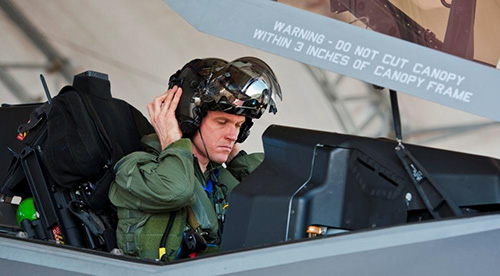 The third version of the helmet, which will be introduced in the fleet in the 2016, features an improved night vision camera, optimized liquid crystal displays, automatic alignment and a much more stable new software. The first generation helmet was mainly used for safety tests. The second-generation one equips the current departments and is used by the Marine Corps, the first body in the world to declare the Initial Operational Capacity F-35B. The third generation helmet will correct the current problems of visual acuity of the second generation system.
The third version of the helmet, which will be introduced in the fleet in the 2016, features an improved night vision camera, optimized liquid crystal displays, automatic alignment and a much more stable new software. The first generation helmet was mainly used for safety tests. The second-generation one equips the current departments and is used by the Marine Corps, the first body in the world to declare the Initial Operational Capacity F-35B. The third generation helmet will correct the current problems of visual acuity of the second generation system.
In April 2015, a single helmet cost just over 400 thousand dollars. Previous versions of the helmet had problems in the presence of turbulence. There have been cases of latency in the video that caused motion sickness in the pilots. Then, night vision technology didn't work as it should. The "green light" obscured the view of the pilots. Things were so bad that in the 2011 the Pentagon commissioned BAE Systems with an alternative helmet if it was not in development. In the 2013, it was decided to continue with that of Rockwell Collins. The third generation helmet presents improvements in terms of software and night vision. However, there are problems of sharing between fighters when they fly together. The problem does not arise when the training consists of two fighters. In that case, the two F-35 are able to share information to the bitter end without problems. A formation of four fighters, on the other hand, provides a real unstable picture, providing pilots with false signals on the targets.
The concept
The biggest problem of the F-35 is conceptual: having thought of making a single aircraft that was a fighter, a bomber, an aircraft for Close Air Support, that could land on an aircraft carrier or that could take off vertically, has entailed a series of design compromises that did not make the JSF excelled in any role. The cost then. The F-35 will demand 12 billions of dollars a year (for the USA) up to the 2038, an unsustainable figure unless all other projects (such as the next generation bomber or the development of unmanned aircraft) do not be resized.
Advertised as the ultimate fighter
From the Pentagon they confirmed that to impose air supremacy in a given context with X opponents, it would take eight F-35. To eliminate the same enemies, two F-22 would suffice. These are data that must make us reflect on the real capabilities of the F-35 cell and on its radar section, lower than the F-22. Having a low radar signature does not mean being superior to a heavier and more "visible" fighter.
The F-35 should give undeniable advantages in a given operational context thanks to its low observability, on-board sensor capabilities and information integration with other platforms. Factors that give the F-35 a huge advantage over the aircraft it will replace, but fifth-generation aircraft, such as the F-22 and the F-35 are not pure fighters, they are not real fighters. They are aircraft optimized for different threat regimes and capable of carrying out various missions. Precisely the specific aircraft no longer exists. Instead, there is the multirole aerial platform that can carry out a myriad of missions very well, probably not excelling in any role.
The F-35 was not designed for dogfighting nor for dueling in one against one. It was designed to eliminate the enemy from a distance. Should it fail, the F-35 without pure stock hunting may not return to the base. And it is a fact.
That millionaire oversight
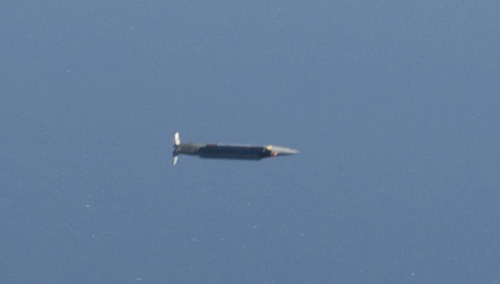 The F-35B was designed to carry eight SDB-IIs internally. These bombs would allow the F-35 pilot to hit eight different targets over 70 kilometers away and with absolute precision. The SDB-IIs are designed to change their course in flight and follow the objectives through infrared or moving laser guidance systems. The F-35B, however, can only accommodate four SDB-II due to the internal hold which is significantly smaller than the A and C versions due to the design of the Stovl aircraft. The US Navy wanted to immediately equip the F-35B with the SDB-II, but preferred to carry on the integration on the F / A-18 Super Hornet.
The F-35B was designed to carry eight SDB-IIs internally. These bombs would allow the F-35 pilot to hit eight different targets over 70 kilometers away and with absolute precision. The SDB-IIs are designed to change their course in flight and follow the objectives through infrared or moving laser guidance systems. The F-35B, however, can only accommodate four SDB-II due to the internal hold which is significantly smaller than the A and C versions due to the design of the Stovl aircraft. The US Navy wanted to immediately equip the F-35B with the SDB-II, but preferred to carry on the integration on the F / A-18 Super Hornet.
It should be noted that the software necessary to implement the SDB-II will be part of the 4 Block, whose release is foreseen in the 2022. Although the Pentagon was aware of the SDB-II problem since the 2007, it was now impossible to change the main design of bombs and fighters. The other weapon systems linked to the Block 4 software are the AGM-154 Weapon Joint Stand-Off, the Joint Strike Missile of the Norwegian Kongsberg, the Turkish SOM and the AIM-9X Sidewinder Block II.
We need a technical response, not a political one
If he had been a demonstrator, the F-35 technologies would have been implemented on different platforms, but this was not the case.
The 55 years of life of the F-35 fighter will cost the United States 1500 billions of dollars. In addition to the United States, hunting was ordered by Great Britain, Australia, Italy, Turkey, Norway, the Netherlands, Japan, South Korea and Israel.
(photo: Lockheed Martin / Martin Baker)

